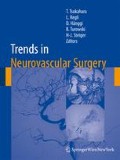Abstract
Background: Criteria to decide whether carotid endarterectomy (CEA) or carotid artery stenting (CAS) is the best mode of therapy in a specific case of cervical carotid stenosis have not been established. Overall, recent randomized clinical trials have reported that the effect on the prevention of stroke is not significantly different between CEA and CAS. CEA is more appropriate than CAS for soft atherosclerotic plaques, since such soft plaques are associated with a high incidence of ischemic complications during CAS. Therefore identification of the plaque type with noninvasive preoperative examinations plays an important role for selecting the suitable surgical method, CEA or CAS. Objective: The objective of this study was to evaluate the association among findings of carotid ultrasonography (carotid US), black blood magnetic resonance imaging (BB-MRI), and the histopathological findings of plaque specimens removed during CEA, and secondly to consider whether these diagnostic tools are useful to predict the characteristics of carotid plaques. Method: We investigated a total of 25 consecutive patients who underwent CEA from November 2008 to June 2010 at Kyoto Medical Center. We examined carotid plaque in 17 patients employing both carotid US and BB-MRI, 7 patients by carotid US, and 1 patient by BB-MRI. The plaque echogenicity was qualitatively assessed as low, intermediate, or high, and the MR signal intensity of the carotid plaque was classified as low or high compared with the intensity of the ipsilateral sternocleidomastoid muscle. The plaque specimens were macroscopically and pathophysiologically classified as soft or hard plaque. Results: All low-echogenic plaques on carotid US were histologically soft plaques. The high-intensity plaques on T1-weighted imaging (T1WI) showed a tendency toward soft plaque. Thirteen of 14 plaques with high signal intensity on T1WI were morphologically soft. Eleven of 14 plaques with an intermediate echogenicity on carotid US were also morphologically soft. Conclusion: The findings of carotid ultrasonography and BB-MRI are closely associated with the CEA specimen’s morphology. Ultrasonography alone is insufficient to diagnose the plaque type accurately in some patients. Employing both carotid US and BB-MRI is useful for evaluating the characteristics of carotid plaque.
Access this chapter
Tax calculation will be finalised at checkout
Purchases are for personal use only
References
Biasi GM, Froio A (2004) Carotid plaque echolucency increases the risk of stroke in carotid stenting: the Imaging in Carotid Angioplasty and Risk of Stroke (ICAROS) study. Circulation 110:756–762
Ederle J, Dobson J (2010) Carotid artery stenting compared with endarterectomy in patients with symptomatic carotid stenosis (International Carotid Stenting Study): an interim analysis of a randomized controlled trial. Lancet 375:985–997
Halliday A, Mansfield A (2004) Prevention of disabling and fatal strokes by successful carotid endarterectomy in patients without recent neurological symptoms: randomized controlled trial. Lancet 363:1491–1502
Henry M, Henry I (2002) Benefits of cerebral protection during carotid stenting with the PercuSurge GuardWire system: midterm results. J Endovasc Ther 9:1–13
Kolodgie FD, Gold HK (2003) Intraplaque hemorrhage and progression of coronary atheroma. N Engl J Med 349:2316–2325
Mas JL, Chatellier G (2006) Endarterectomy versus stenting in patients with symptomatic severe carotid stenosis. N Engl J Med 355:1660–1671
Ohki T, Marin ML (1998) Ex vivo human carotid artery bifurcation stenting: correlation of lesion characteristics with embolic potential. J Vasc Surg 27:463–471
Redgrave JN, Lovett JK et al (2006) Histological assessment of 526 symptomatic carotid plaques in relation to the nature and timing of ischemic symptoms: Oxford plaque study. Circulation 113: 2320–2328
Ringleb PA, Allenberg J (2006) 30 day results from the SPACE trial of stent-protected angioplasty versus carotid endarterectomy in symptomatic patients: a randomized non-inferiority trial. Lancet 36:1239–1247
Rothwell PM, Eliasziw M (2004) Endarterectomy for symptomatic carotid stenosis in relation to clinical subgroups and timing of surgery. Lancet 363:915–924
Saam T, Hatsukami TS (2007) The vulnerable, or high-risk, atherosclerotic plaque: noninvasive MR imaging for characterization and assessment. Radiology 244:64–77
Touze E, Toussaint JF (2007) Reproducibility of high-resolution MRI for the identification and the quantification of carotid atherosclerotic plaque components: consequences for prognosis studies and therapeutic trials. Stroke 38:1812–1819
Yadav JS, Wholey MH (2004) Protected carotid-artery stenting versus endarterectomy in high-risk patients. N Engl J Med 351:1493–1501
Yoshida K (2008) Characterization of carotid atherosclerosis and detection of soft plaque with use of black-blood MR imaging. Am J Neuroradiol 29:868–874
Author information
Authors and Affiliations
Corresponding author
Editor information
Editors and Affiliations
Rights and permissions
Copyright information
© 2011 Springer-Verlag/Wien
About this paper
Cite this paper
Arai, D. et al. (2011). Characteristics of Carotid Plaque Findings on Ultrasonography and Black Blood Magnetic Resonance Imaging in Comparison with Pathological Findings. In: Tsukahara, T., Regli, L., Hänggi, D., Turowski, B., Steiger, HJ. (eds) Trends in Neurovascular Surgery. Acta Neurochirurgica Supplementum, vol 112. Springer, Vienna. https://doi.org/10.1007/978-3-7091-0661-7_3
Download citation
DOI: https://doi.org/10.1007/978-3-7091-0661-7_3
Published:
Publisher Name: Springer, Vienna
Print ISBN: 978-3-7091-0660-0
Online ISBN: 978-3-7091-0661-7
eBook Packages: MedicineMedicine (R0)

